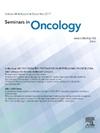Prostate cancer in Türkiye: Trend analysis of incidence and mortality rates
IF 2.5
3区 医学
Q2 ONCOLOGY
引用次数: 0
Abstract
Prostate cancer is a significant global health concern, with substantial regional variations in incidence and mortality rates. In Türkiye, it's the second most common cancer and fourth leading cause of cancer-related deaths among men. This study aims to analyze trends in prostate cancer incidence and mortality rates in Türkiye. Prostate cancer trends in Türkiye is analyzed by using data of incidence from Türkiye Cancer Statistics Reports and mortality from TurkStat. Trends in incidence and mortality rates were analyzed using Joinpoint regression, evaluating average annual percentage changes and annual percentage change (APC). From 2004 to 2018, age-standardized prostate cancer incidence rate increased from 24.9 to 40.3 per 100,000, with the highest in aged 75 and older. The Annual Average Percentage Change (AAPC) was 2.6%[CI, 1.1 to 4.3] overall, with specific rates of 2.3% [CI, 0.5 to 3.5] in the 50–54 and −1.9% [CI, −3.7 to −0.1] in the 80–84 age group. The APC was 9.2% [CI, 3.6 to 24.8] from 2004 to 2008. From 2016–2018, APCs in 50–54 and 60–64 age groups are 13.4% [CI, 3.6 to 20.4] and 13.7% [CI, 0.4 to 23.6], respectively. Mortality rate ranged from 7.3 to 9.2 per 100,000 from 2009 to 2022, with a 4.9% [CI, 2.1 to 11.6] increase in 2009–2014 and a 1.9%–1.9%[CI, 4.4 to −0.6] decrease in 2014–2022. The incidence rate of prostate cancer in Türkiye increased until 2008, but then stabilised with the rates rising at the age of 50–54 and decreasing at the age of 80–84 years. Mortality rates initially increased but declined in the last 8 years. Further research is needed to explore factors influencing these trends.
日本前列腺癌:发病率和死亡率的趋势分析
前列腺癌是一个重大的全球健康问题,在发病率和死亡率方面存在很大的区域差异。在日本,它是第二大常见癌症,也是男性癌症相关死亡的第四大原因。本研究旨在分析日本前列腺癌发病率和死亡率的趋势。通过使用来自 rkiye癌症统计报告的发病率数据和来自TurkStat的死亡率数据,分析了 rkiye癌症统计报告的前列腺癌趋势。采用关节点回归分析发病率和死亡率的趋势,评估年平均百分比变化和年百分比变化(APC)。从2004年到2018年,年龄标准化前列腺癌发病率从24.9 / 10万上升到40.3 / 10万,其中75岁及以上人群发病率最高。总体而言,年平均百分比变化(AAPC)为2.6%[CI, 1.1至4.3],50-54岁年龄组的具体比率为2.3% [CI, 0.5至3.5],80-84岁年龄组的具体比率为- 1.9% [CI, - 3.7至- 0.1]。2004 - 2008年APC为9.2% [CI, 3.6 ~ 24.8]。2016-2018年,50-54岁和60-64岁年龄组的apc分别为13.4% [CI, 3.6 - 20.4]和13.7% [CI, 0.4 - 23.6]。2009年至2022年,死亡率为每10万人7.3至9.2人,2009 - 2014年上升4.9% [CI, 2.1至11.6],2014-2022年下降1.9%-1.9% [CI, 4.4至- 0.6]。日本人前列腺癌的发病率在2008年之前一直在上升,但随后趋于稳定,在50-54岁时发病率上升,在80-84岁时发病率下降。死亡率最初有所上升,但在过去8年中有所下降。需要进一步的研究来探索影响这些趋势的因素。
本文章由计算机程序翻译,如有差异,请以英文原文为准。
求助全文
约1分钟内获得全文
求助全文
来源期刊

Seminars in oncology
医学-肿瘤学
CiteScore
6.60
自引率
0.00%
发文量
58
审稿时长
104 days
期刊介绍:
Seminars in Oncology brings you current, authoritative, and practical reviews of developments in the etiology, diagnosis and management of cancer. Each issue examines topics of clinical importance, with an emphasis on providing both the basic knowledge needed to better understand a topic as well as evidence-based opinions from leaders in the field. Seminars in Oncology also seeks to be a venue for sharing a diversity of opinions including those that might be considered "outside the box". We welcome a healthy and respectful exchange of opinions and urge you to approach us with your insights as well as suggestions of topics that you deem worthy of coverage. By helping the reader understand the basic biology and the therapy of cancer as they learn the nuances from experts, all in a journal that encourages the exchange of ideas we aim to help move the treatment of cancer forward.
 求助内容:
求助内容: 应助结果提醒方式:
应助结果提醒方式:


